前言
公司將項(xiàng)目由struts2轉(zhuǎn)到springmvc了,由于公司業(yè)務(wù)是境外服務(wù),所以對(duì)國(guó)際化功能需求很高。struts2自帶的國(guó)際化功能相對(duì)springmvc來(lái)說(shuō)更加完善,不過(guò)spring很大的特性就是可定定制化性強(qiáng),所以在公司項(xiàng)目移植的到springmvc的時(shí)候增加了其國(guó)際化的功能。特此整理記錄并且完善了一下。
本文主要實(shí)現(xiàn)的功能:
從文件夾中直接加載多個(gè)國(guó)際化文件后臺(tái)設(shè)置前端頁(yè)面顯示國(guó)際化信息的文件利用攔截器和注解自動(dòng)設(shè)置前端頁(yè)面顯示國(guó)際化信息的文件
注:本文不詳細(xì)介紹怎么配置國(guó)際化,區(qū)域解析器等。
實(shí)現(xiàn)
國(guó)際化項(xiàng)目初始化
先創(chuàng)建一個(gè)基本的spring-boot+thymeleaf+國(guó)際化信息(message.properties)項(xiàng)目,如果有需要可以從我的github下載。
簡(jiǎn)單看一下項(xiàng)目的目錄和文件

其中i18napplication.java設(shè)置了一個(gè)cookielocaleresolver,采用cookie來(lái)控制國(guó)際化的語(yǔ)言。還設(shè)置一個(gè)localechangeinterceptor攔截器來(lái)攔截國(guó)際化語(yǔ)言的變化。
|
1
2
3
4
5
6
7
8
9
10
11
12
13
14
15
16
17
18
19
20
21
22
23
24
25
26
|
@springbootapplication@configurationpublic class i18napplication { public static void main(string[] args) { springapplication.run(i18napplication.class, args); } @bean public localeresolver localeresolver() { cookielocaleresolver slr = new cookielocaleresolver(); slr.setcookiemaxage(3600); slr.setcookiename("language");//設(shè)置存儲(chǔ)的cookie的name為language return slr; } @bean public webmvcconfigurer webmvcconfigurer() { return new webmvcconfigurer() { //攔截器 @override public void addinterceptors(interceptorregistry registry) { registry.addinterceptor(new localechangeinterceptor()).addpathpatterns("/**"); } }; }} |
我們?cè)倏匆幌耯ello.html中寫(xiě)了什么:
|
1
2
3
4
5
6
7
8
9
10
|
<!doctype html><html xmlns="http://www.w3.org/1999/xhtml" xmlns:th="http://www.thymeleaf.org"><head> <title>hello world!</title></head><body><h1 th:text="#{i18n_page}"></h1><h3 th:text="#{hello}"></h3></body></html> |
現(xiàn)在啟動(dòng)項(xiàng)目并且訪問(wèn)http://localhost:9090/hello(我在application.properties)中設(shè)置了端口為9090。
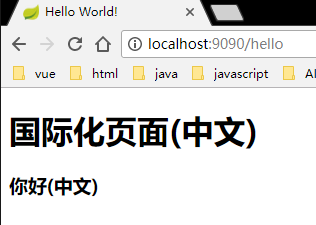
由于瀏覽器默認(rèn)的語(yǔ)言是中文,所以他默認(rèn)會(huì)去messages_zh_cn.properties中找,如果沒(méi)有就會(huì)去messages.properties中找國(guó)際化詞。
然后我們?cè)跒g覽器中輸入http://localhost:9090/hello?locale=en_us,語(yǔ)言就會(huì)切到英文。同樣的如果url后參數(shù)設(shè)置為locale=zh_ch,語(yǔ)言就會(huì)切到中文。
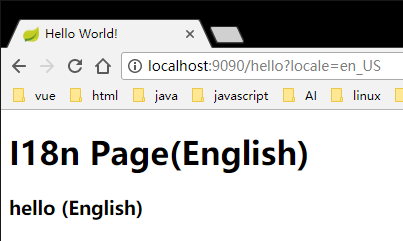
從文件夾中直接加載多個(gè)國(guó)際化文件
在我們hello.html頁(yè)面中,只有'i18n_page'和'hello'兩個(gè)國(guó)際化信息,然而在實(shí)際項(xiàng)目中肯定不會(huì)只有幾個(gè)國(guó)際化信息那么少,通常都是成千上百個(gè)的,那我們肯定不能把這么多的國(guó)際化信息都放在messages.properties一個(gè)文件中,通常都是把國(guó)際化信息分類(lèi)存放在幾個(gè)文件中。但是當(dāng)項(xiàng)目大了以后,這些國(guó)際化文件也會(huì)越來(lái)越多,這時(shí)候在application.properties文件中一個(gè)個(gè)的去配置這個(gè)文件也是不方便的,所以現(xiàn)在我們實(shí)現(xiàn)一個(gè)功能自動(dòng)加載制定目錄下所有的國(guó)際化文件。
繼承resourcebundlemessagesource
在項(xiàng)目下創(chuàng)建一個(gè)類(lèi)繼承resourcebundlemessagesource或者reloadableresourcebundlemessagesource,起名為messageresourceextension。并且注入到bean中起名為messagesource,這里我們繼承resourcebundlemessagesource。
|
1
2
3
|
@component("messagesource")public class messageresourceextension extends resourcebundlemessagesource {} |
注意這里我們的component名字必須為'messagesource',因?yàn)樵诔跏蓟?code>applicationcontext的時(shí)候,會(huì)查找bean名為'messagesource'的bean。這個(gè)過(guò)程在abstractapplicationcontext.java中,我們看一下源代碼
|
1
2
3
4
5
6
7
8
9
10
11
12
|
/*** initialize the messagesource.* use parent's if none defined in this context.*/protected void initmessagesource() { configurablelistablebeanfactory beanfactory = getbeanfactory(); if (beanfactory.containslocalbean(message_source_bean_name)) { this.messagesource = beanfactory.getbean(message_source_bean_name, messagesource.class); ... }}... |
在這個(gè)初始化messagesource的方法中,beanfactory查找注入名為message_source_bean_name(messagesource)的bean,如果沒(méi)有找到,就會(huì)在其父類(lèi)中查找是否有該名的bean。
實(shí)現(xiàn)文件加載
現(xiàn)在我們可以開(kāi)始在剛才創(chuàng)建的messageresourceextension
中寫(xiě)加載文件的方法了。
|
1
2
3
4
5
6
7
8
9
10
11
12
13
14
15
16
17
18
19
20
21
22
23
24
25
26
27
28
29
30
31
32
33
34
35
36
37
38
39
40
41
42
43
44
45
46
47
48
49
50
51
52
53
54
55
56
57
58
59
60
61
62
63
64
65
66
67
68
69
70
71
72
73
74
75
76
77
78
79
80
81
82
83
84
85
86
87
88
89
90
91
|
@component("messagesource")public class messageresourceextension extends resourcebundlemessagesource { private final static logger logger = loggerfactory.getlogger(messageresourceextension.class); /** * 指定的國(guó)際化文件目錄 */ @value(value = "${spring.messages.basefolder:i18n}") private string basefolder; /** * 父messagesource指定的國(guó)際化文件 */ @value(value = "${spring.messages.basename:message}") private string basename; @postconstruct public void init() { logger.info("init messageresourceextension..."); if (!stringutils.isempty(basefolder)) { try { this.setbasenames(getallbasenames(basefolder)); } catch (ioexception e) { logger.error(e.getmessage()); } } //設(shè)置父messagesource resourcebundlemessagesource parent = new resourcebundlemessagesource(); parent.setbasename(basename); this.setparentmessagesource(parent); } /** * 獲取文件夾下所有的國(guó)際化文件名 * * @param foldername 文件名 * @return * @throws ioexception */ private string[] getallbasenames(string foldername) throws ioexception { resource resource = new classpathresource(foldername); file file = resource.getfile(); list<string> basenames = new arraylist<>(); if (file.exists() && file.isdirectory()) { this.getallfile(basenames, file, ""); } else { logger.error("指定的basefile不存在或者不是文件夾"); } return basenames.toarray(new string[basenames.size()]); } /** * 遍歷所有文件 * * @param basenames * @param folder * @param path */ private void getallfile(list<string> basenames, file folder, string path) { if (folder.isdirectory()) { for (file file : folder.listfiles()) { this.getallfile(basenames, file, path + folder.getname() + file.separator); } } else { string i18name = this.geti18filename(path + folder.getname()); if (!basenames.contains(i18name)) { basenames.add(i18name); } } } /** * 把普通文件名轉(zhuǎn)換成國(guó)際化文件名 * * @param filename * @return */ private string geti18filename(string filename) { filename = filename.replace(".properties", ""); for (int i = 0; i < 2; i++) { int index = filename.lastindexof("_"); if (index != -1) { filename = filename.substring(0, index); } } return filename; }} |
依次解釋一下幾個(gè)方法。
-
init()方法上有一個(gè)@postconstruct注解,這會(huì)在messageresourceextension類(lèi)被實(shí)例化之后自動(dòng)調(diào)用init()方法。這個(gè)方法獲取到basefolder目錄下所有的國(guó)際化文件并設(shè)置到basenameset中。并且設(shè)置一個(gè)parentmessagesource,這會(huì)在找不到國(guó)際化信息的時(shí)候,調(diào)用父messagesource來(lái)查找國(guó)際化信息。 -
getallbasenames()方法獲取到basefolder的路徑,然后調(diào)用getallfile()方法獲取到該目錄下所有的國(guó)際化文件的文件名。 -
getallfile()遍歷目錄,如果是文件夾就繼續(xù)遍歷,如果是文件就調(diào)用geti18filename()把文件名轉(zhuǎn)為'i18n/basename/‘格式的國(guó)際化資源名。
所以簡(jiǎn)單來(lái)說(shuō)就是在messageresourceextension被實(shí)例化之后,把'i18n'文件夾下的資源文件的名字,加載到basenames中。現(xiàn)在來(lái)看一下效果。
首先我們?cè)赼pplication.properties文件中添加一個(gè)spring.messages.basefolder=i18n,這會(huì)把'i18n'這個(gè)值賦值給messageresourceextension中的basefolder。
在啟動(dòng)后看到控制臺(tái)里打印出了init信息,表示被@postconstruct注解的init()方法已經(jīng)執(zhí)行。

然后我們?cè)賱?chuàng)建兩組國(guó)際化信息文件:'dashboard'和'merchant',里面分別只有一個(gè)國(guó)際化信息:'dashboard.hello'和'merchant.hello'。
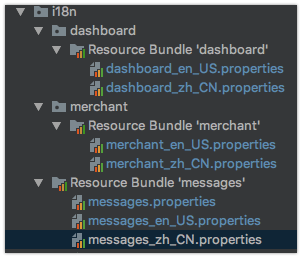
之后再修改一下hello.html文件,然后訪問(wèn)hello頁(yè)面。
|
1
2
3
4
5
6
7
8
|
...<body><h1>國(guó)際化頁(yè)面!</h1><p th:text="#{hello}"></p><p th:text="#{merchant.hello}"></p><p th:text="#{dashboard.hello}"></p></body>... |
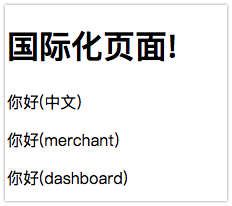

可以看到網(wǎng)頁(yè)中加載了'message','dashboard'和'merchant'中的國(guó)際化信息,說(shuō)明我們已經(jīng)成功一次性加載了'i18n'文件夾下的文件。
后臺(tái)設(shè)置前端頁(yè)面顯示國(guó)際化信息的文件
s剛才那一節(jié)我們成功加載了多個(gè)國(guó)際化文件并顯示出了他們的國(guó)際化信息。但是'dashboard.properties'中的國(guó)際化信息為'dashboard.hello'而'merchant.properties'中的是'merchant.hello',這樣每個(gè)都要寫(xiě)一個(gè)前綴豈不是很麻煩,現(xiàn)在我想要在'dashboard'和'merchant'的國(guó)際化文件中都只寫(xiě)'hello'但是顯示的是'dashboard'或'merchant'中的國(guó)際化信息。
在messageresourceextension重寫(xiě)resolvecodewithoutarguments方法(如果有字符格式化的需求就重寫(xiě)resolvecode方法)。
|
1
2
3
4
5
6
7
8
9
10
11
12
13
14
15
16
17
18
19
20
21
22
23
24
25
26
27
28
|
@component("messagesource")public class messageresourceextension extends resourcebundlemessagesource { ... public static string i18n_attribute = "i18n_attribute"; @override protected string resolvecodewithoutarguments(string code, locale locale) { // 獲取request中設(shè)置的指定國(guó)際化文件名 servletrequestattributes attr = (servletrequestattributes) requestcontextholder.currentrequestattributes(); final string i18file = (string) attr.getattribute(i18n_attribute, requestattributes.scope_request); if (!stringutils.isempty(i18file)) { //獲取在basenameset中匹配的國(guó)際化文件名 string basename = getbasenameset().stream() .filter(name -> stringutils.endswithignorecase(name, i18file)) .findfirst().orelse(null); if (!stringutils.isempty(basename)) { //得到指定的國(guó)際化文件資源 resourcebundle bundle = getresourcebundle(basename, locale); if (bundle != null) { return getstringornull(bundle, code); } } } //如果指定i18文件夾中沒(méi)有該國(guó)際化字段,返回null會(huì)在parentmessagesource中查找 return null; } ...} |
在我們重寫(xiě)的resolvecodewithoutarguments方法中,從httpservletrequest中獲取到‘i18n_attribute'(等下再說(shuō)這個(gè)在哪里設(shè)置),這個(gè)對(duì)應(yīng)我們想要顯示的國(guó)際化文件名,然后我們?cè)?code>basenameset中查找該文件,再通過(guò)getresourcebundle獲取到資源,最后再getstringornull獲取到對(duì)應(yīng)的國(guó)際化信息。
現(xiàn)在我們到我們的hellocontroller里加兩個(gè)方法。
|
1
2
3
4
5
6
7
8
9
10
11
12
13
14
15
16
17
18
19
20
21
|
@controllerpublic class hellocontroller { @getmapping("/hello") public string index(httpservletrequest request) { request.setattribute(messageresourceextension.i18n_attribute, "hello"); return "system/hello"; } @getmapping("/dashboard") public string dashboard(httpservletrequest request) { request.setattribute(messageresourceextension.i18n_attribute, "dashboard"); return "dashboard"; } @getmapping("/merchant") public string merchant(httpservletrequest request) { request.setattribute(messageresourceextension.i18n_attribute, "merchant"); return "merchant"; }} |
看到我們?cè)诿總€(gè)方法中都設(shè)置一個(gè)對(duì)應(yīng)的'i18n_attribute',這會(huì)在每次請(qǐng)求中設(shè)置對(duì)應(yīng)的國(guó)際化文件,然后在messageresourceextension中獲取。
這時(shí)我們看一下我們的國(guó)際化文件,我們可以看到所有關(guān)鍵字都是'hello',但是信息卻不同。



同時(shí)新增兩個(gè)html文件分別是'dashboard.html'和'merchant.html',里面只有一個(gè)'hello'的國(guó)際化信息和用于區(qū)分的標(biāo)題。
|
1
2
3
4
5
|
<!-- 這是hello.html --><body><h1>國(guó)際化頁(yè)面!</h1><p th:text="#{hello}"></p></body> |
|
1
2
3
4
5
|
<!-- 這是dashboard.html --><body><h1>國(guó)際化頁(yè)面(dashboard)!</h1><p th:text="#{hello}"></p></body> |
|
1
2
3
4
5
|
<!-- 這是merchant.html --><body><h1>國(guó)際化頁(yè)面(merchant)!</h1><p th:text="#{hello}"></p></body> |
這時(shí)我們啟動(dòng)項(xiàng)目看一下。


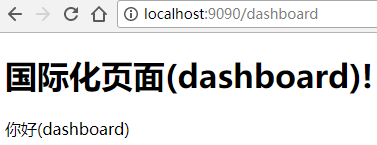
可以看到雖然在每個(gè)頁(yè)面的國(guó)際化詞都是'hello',但是我們?cè)趯?duì)應(yīng)的頁(yè)面顯示了我們想要顯示的信息。
利用攔截器和注解自動(dòng)設(shè)置前端頁(yè)面顯示國(guó)際化信息的文件
雖然已經(jīng)可以指定對(duì)應(yīng)的國(guó)際化信息,但是這樣要在每個(gè)controller里的httpservletrequest中設(shè)置國(guó)際化文件實(shí)在太麻煩了,所以現(xiàn)在我們實(shí)現(xiàn)自動(dòng)判定來(lái)顯示對(duì)應(yīng)的文件。
首先我們創(chuàng)建一個(gè)注解,這個(gè)注解可以放在類(lèi)上或者方法上。
|
1
2
3
4
5
6
7
8
|
@target({elementtype.type, elementtype.method})@retention(retentionpolicy.runtime)public @interface i18n { /** * 國(guó)際化文件名 */ string value();} |
然后我們把這個(gè)創(chuàng)建的i18n 注解放在剛才的controller方法中,為了顯示他的效果,我們?cè)賱?chuàng)建一個(gè)shopcontroller和usercontroller,同時(shí)也創(chuàng)建對(duì)應(yīng)的'shop'和'user'的國(guó)際化文件,內(nèi)容也都是一個(gè)'hello'。
|
1
2
3
4
5
6
7
8
9
10
11
12
13
14
15
16
17
18
19
|
@controllerpublic class hellocontroller { @getmapping("/hello") public string index() { return "system/hello"; } @i18n("dashboard") @getmapping("/dashboard") public string dashboard() { return "dashboard"; } @i18n("merchant") @getmapping("/merchant") public string merchant() { return "merchant"; }} |
|
1
2
3
4
5
6
7
8
|
@i18n("shop")@controllerpublic class shopcontroller { @getmapping("shop") public string shop() { return "shop"; }} |
|
1
2
3
4
5
6
7
|
@controllerpublic class usercontroller { @getmapping("user") public string user() { return "user"; }} |
我們把i18n注解分別放在hellocontroller下的dashboard和merchant方法下,和shopcontroller類(lèi)上。并且去除了原來(lái)dashboard和merchant方法下設(shè)置‘i18n_attribute'的語(yǔ)句。
準(zhǔn)備工作都做好了,現(xiàn)在看看如何實(shí)現(xiàn)根據(jù)這些注解自動(dòng)的指定國(guó)際化文件。
|
1
2
3
4
5
6
7
8
9
10
11
12
13
14
15
16
17
18
19
20
21
22
23
24
25
26
27
28
29
30
31
32
33
34
35
36
37
38
39
40
41
42
43
44
|
public class messageresourceinterceptor implements handlerinterceptor { @override public void posthandle(httpservletrequest req, httpservletresponse rep, object handler, modelandview modelandview) { // 在方法中設(shè)置i18路徑 if (null != req.getattribute(messageresourceextension.i18n_attribute)) { return; } handlermethod method = (handlermethod) handler; // 在method上注解了i18 i18n i18nmethod = method.getmethodannotation(i18n.class); if (null != i18nmethod) { req.setattribute(messageresourceextension.i18n_attribute, i18nmethod.value()); return; } // 在controller上注解了i18 i18n i18ncontroller = method.getbeantype().getannotation(i18n.class); if (null != i18ncontroller) { req.setattribute(messageresourceextension.i18n_attribute, i18ncontroller.value()); return; } // 根據(jù)controller名字設(shè)置i18 string controller = method.getbeantype().getname(); int index = controller.lastindexof("."); if (index != -1) { controller = controller.substring(index + 1, controller.length()); } index = controller.touppercase().indexof("controller"); if (index != -1) { controller = controller.substring(0, index); } req.setattribute(messageresourceextension.i18n_attribute, controller); } @override public boolean prehandle(httpservletrequest req, httpservletresponse rep, object handler) { // 在跳轉(zhuǎn)到該方法先清除request中的國(guó)際化信息 req.removeattribute(messageresourceextension.i18n_attribute); return true; }} |
簡(jiǎn)單講解一下這個(gè)攔截器。
首先,如果request中已經(jīng)有'i18n_attribute',說(shuō)明在controller的方法中指定設(shè)置了,就不再判斷。
然后判斷一下進(jìn)入攔截器的方法上有沒(méi)有i18n的注解,如果有就設(shè)置'i18n_attribute'到request中并退出攔截器,如果沒(méi)有就繼續(xù)。
再判斷進(jìn)入攔截的類(lèi)上有沒(méi)有i18n的注解,如果有就設(shè)置'i18n_attribute'到request中并退出攔截器,如果沒(méi)有就繼續(xù)。
最后假如方法和類(lèi)上都沒(méi)有i18n的注解,那我們可以根據(jù)controller名自動(dòng)設(shè)置指定的國(guó)際化文件,比如'usercontroller'那么就會(huì)去找'user'的國(guó)際化文件。
現(xiàn)在我們?cè)龠\(yùn)行一下看看效果,看到每個(gè)鏈接都顯示的他們對(duì)應(yīng)的國(guó)際化信息里的內(nèi)容。




最后
剛才完成了我們整個(gè)國(guó)際化增強(qiáng)的基本功能,最后我把全部代碼整理了一下,并且整合了bootstrap4來(lái)展示了一下功能的實(shí)現(xiàn)效果。




詳細(xì)的代碼可以看我github上spring-boot-i18n-pro的代碼
以上就是本文的全部?jī)?nèi)容,希望對(duì)大家的學(xué)習(xí)有所幫助,也希望大家多多支持服務(wù)器之家。
原文鏈接:https://segmentfault.com/a/1190000014538512















